
The Battle of Gettysburg was a battle in the American Civil War fought by Union and Confederate forces between July 1 and July 3, 1863, in and around Gettysburg, Pennsylvania.

George Edward Pickett was a career United States Army officer who became a major general in the Confederate States Army during the American Civil War. He is best remembered for being one of the commanders at Pickett's Charge, the futile and bloody Confederate offensive on the third day of the Battle of Gettysburg that bears his name.
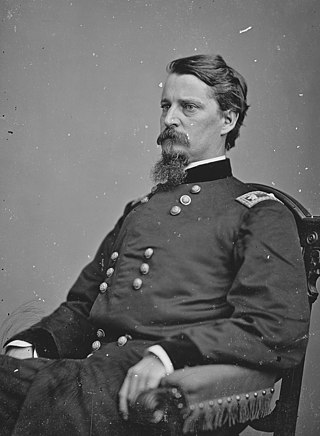
Winfield Scott Hancock was a United States Army officer and the Democratic nominee for President of the United States in 1880. He served with distinction in the Army for four decades, including service in the Mexican–American War and as a Union general in the American Civil War. Known to his Army colleagues as "Hancock the Superb," he was noted in particular for his personal leadership at the Battle of Gettysburg in 1863. His military service continued after the Civil War, as Hancock participated in the military Reconstruction of the South and the U.S.' ethnic cleansing of Native Americans at the Western frontier. This concluded with the Medicine Lodge Treaty. From 1881 to 1885 he was president of the Aztec Club of 1847 for veteran officers of the Mexican-American War.

Gettysburg National Cemetery is a United States national cemetery in Gettysburg, Pennsylvania created for Union casualties from the Battle of Gettysburg in the American Civil War. The Battle of Gettysburg, which was fought between July 1 to 3, 1863, resulted in the largest number of casualties of any Civil War battle but also was considered the war's turning point, leading ultimately to the Union victory.

The Gettysburg Battlefield is the area of the July 1–3, 1863, military engagements of the Battle of Gettysburg within and around the borough of Gettysburg, Pennsylvania. Locations of military engagements extend from the 4-acre (1.6 ha) site of the first shot at Knoxlyn Ridge on the west of the borough, to East Cavalry Field on the east. A military engagement prior to the battle was conducted at the Gettysburg Railroad trestle over Rock Creek, which was burned on June 27.
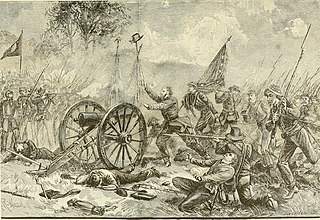
Pickett's Charge, also known as the Pickett–Pettigrew–Trimble Charge, was an infantry assault ordered by Confederate General Robert E. Lee against Major General George G. Meade's Union positions on the last day of the Battle of Gettysburg in Pennsylvania during the Civil War. Confederate troops made a frontal assault toward the center of Union lines, ultimately being repulsed with heavy casualties. Suffering from a lack of preparation and problems from the onset, the attack was a costly mistake that decisively ended Lee's invasion of the north and forced a retreat back to Virginia.

Lewis Addison Armistead was a career United States Army officer who became a brigadier general in the Confederate States Army during the American Civil War. On July 3, 1863, as part of Pickett's Charge during the Battle of Gettysburg, Armistead led his brigade to the farthest point reached by Confederate forces during the charge, a point now referred to as the high-water mark of the Confederacy. However, he and his men were overwhelmed, and he was wounded and captured by Union troops. He died in a field hospital two days later.

The Killer Angels is a 1974 historical novel by Michael Shaara that was awarded the Pulitzer Prize for Fiction in 1975. The book depicts the three days of the Battle of Gettysburg during the American Civil War, and the days leading up to it: June 29, 1863, as the troops of both the Union and the Confederacy move into battle around the town of Gettysburg, Pennsylvania, and July 1, July 2, and July 3, when the battle was fought. The story is character-driven and told from the perspective of various historical figures from both the Confederacy and the Union. A film adaptation of the novel, titled Gettysburg, was released in 1993.

Gettysburg is a 1993 American epic war film about the Battle of Gettysburg in the American Civil War. Written and directed by Ronald F. Maxwell, the film was adapted from the 1974 historical novel The Killer Angels by Michael Shaara. It features an ensemble cast, including Tom Berenger as James Longstreet, Jeff Daniels as Joshua Chamberlain, Martin Sheen as Robert E. Lee, Stephen Lang as George Pickett, and Sam Elliott as John Buford.

"Kathleen Mavourneen" is a song written in 1837, composed by Frederick Crouch with lyrics by a Mrs. Crawford. Crawford's name is variously cited as Annie, Julia, Louise Macartney, Louise Matilda Jane, or Marion; Crouch is also sometimes incorrectly cited as the author of the song's lyrics. It was popular during the American Civil War. "Mavourneen" is a term of endearment derived from the Irish Gaelic mo mhuirnín, meaning "my beloved".
Richard Brooke Garnett was a career United States Army officer and a Confederate general in the American Civil War. He was court-martialed by Stonewall Jackson for his actions in command of the Stonewall Brigade at the First Battle of Kernstown, and killed during Pickett's Charge at the Battle of Gettysburg.

Cemetery Ridge is a geographic feature in Gettysburg National Military Park, south of the town of Gettysburg, Pennsylvania, that figured prominently in the Battle of Gettysburg, July 1 to July 3, 1863. It formed a primary defensive position for the Union Army during the battle, roughly the center of what is popularly known as the "fish-hook" line. The Confederate States Army launched attacks on the Union positions on the second and third days of the battle, but were driven back both times.

John Badger Bachelder was a portrait and landscape painter, lithographer, and photographer, but best known as the preeminent 19th-century historian of the Battle of Gettysburg in the American Civil War. He was a dominant factor in the preservation and memorialization of the Gettysburg Battlefield in the latter part of the century.
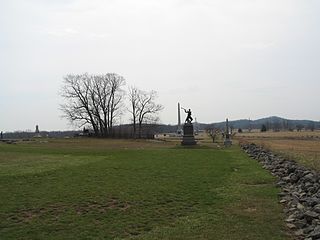
The high-water mark of the Confederacy or high tide of the Confederacy refers to an area on Cemetery Ridge near Gettysburg, Pennsylvania, marking the farthest point reached by Confederate forces during Pickett's Charge on July 3, 1863. Similar to a high water mark of water, the term is a reference to arguably the Confederate Army's best chance of achieving victory in the war. The line of advance was east of "The Angle" stone wall.
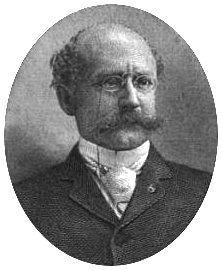
Henry Harrison Bingham was an American politician from Pennsylvania who served as a Republican member of the U.S. House of Representatives for Pennsylvania's 1st congressional district from 1879 to 1912. He was a Union Army officer in the American Civil War, fought in some of the key battles of the war and received the United States Military's highest award for valor, the Medal of Honor, for his actions at the Battle of the Wilderness.
The Battle of Gettysburg, also known as the Gettysburg Cyclorama, is a cyclorama painting by the French artist Paul Philippoteaux depicting Pickett's Charge, the climactic Confederate attack on the Union forces during the Battle of Gettysburg on July 3, 1863.

Jakob Otto Schweizer was a Swiss-American sculptor noted for his work on war memorials.

The 72nd Pennsylvania Infantry Monument is an 1891 statuary memorial on the Gettysburg Battlefield. It is located on Cemetery Ridge, by The Angle and the copse of trees, where Union forces – including the 72nd Pennsylvania Infantry – beat back Confederate forces engaged in Pickett's Charge.

The Gettysburg Battlefield Memorial Association (GBMA) was an historic preservation membership organization and is the eponym for the battlefield's memorial association era. The association was chartered by the Commonwealth of Pennsylvania on April 13, 1864, after attorney David McConaughy recommended on August 14, 1863, a preservation association to sell membership stock for battlefield fundraising. McConaughy transferred his land acquired in 1863 to the GBMA, and the association's boardmembers were initially local officials. The GBMA sold stock to raise money, hired a superintendent at $1000/yr, added to McConaughy's land holdings, and operated a wooden observation tower on East Cemetery Hill from 1878–95.
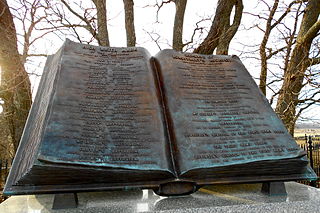
The High Water Mark of the Rebellion Monument is a Gettysburg Battlefield memorial which identifies the Confederate Army of Northern Virginia units of the infantry attack on the Battle of Gettysburg, third day, with a large bronze tablet, as well as the Union Army of the Potomac's "respective troops who met or assisted to repulse Longstreet's Assault." The memorial is named for the line of dead and wounded of Pickett's Charge which marked the deepest penetration into the Union line at The Angle when "4,500 men threw down their arms and came in as prisoners". The line is now generally marked with unit monuments which are also historic district contributing structures. The High Water Mark monument is accessible via Hancock Avenue which has parking spaces alongside, and a path leads to the site from a parking lot at the former Cyclorama Building at Gettysburg, which served for fifty years as a Gettysburg Battlefield visitor center by the National Park Service until it was demolished in 2013.


















